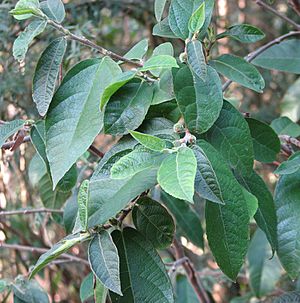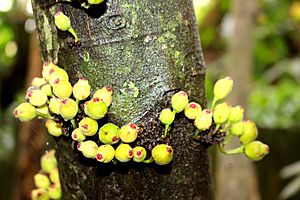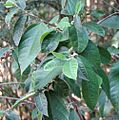Sandpaper fig facts for kids
Quick facts for kids Sandpaper fig |
|
|---|---|
 |
|
 |
|
| fruit demonstrating cauliflory | |
| Scientific classification | |
 |
|
| Occurrence data from AVH :blue dots represent detected outliers; red dots cultivated plants; and cyan dots points not tagged in either way | |
| Synonyms | |
|
Ficus stephanocarpa Warb. |
The Ficus coronata, also known as the sandpaper fig or creek sandpaper fig, is a type of fig tree. It grows naturally in Australia. You can find it along the eastern coast, from Mackay in Central Queensland, through New South Wales, and a little bit into Victoria near Mallacoota. This tree likes to grow near rivers and in rainforests or open forests. It gets its common name because its leaves feel rough, just like sandpaper!
Contents
About the Sandpaper Fig's Name
The sandpaper fig was first described in 1818 by an Italian expert named Marquese di Spigno. Its scientific name, coronata, comes from a Latin word meaning "crowned". This refers to a ring of tiny bristles that look like a crown around the top of its fruit. Another scientific name, Ficus stephanocarpa, was given by a German botanist named Otto Warburg. This name also means 'crowned fruit'.
What Does the Sandpaper Fig Look Like?
The sandpaper fig is usually a small tree. It can grow between 6 to 12 meters (about 20 to 40 feet) tall. It can also spread out 3 to 5 meters (about 10 to 16 feet) wide. Its trunk is dark brown. The leaves are shaped like an oval or an egg. They are about 5 to 15 centimeters (2 to 6 inches) long and 2 to 5 centimeters (1 to 2 inches) wide. The top side of the leaves feels very rough, just like sandpaper. New leaves and branches are often hairy. The fruit is oval-shaped and juicy. It is about 1.5 centimeters (0.6 inches) long and covered in thick hairs.
Where the Sandpaper Fig Grows
You can find the sandpaper fig mostly along water channels and in valleys within rainforests. Sometimes, it also grows in more open forests. It often grows near another tree called the rough-barked apple. In Kanangra-Boyd National Park, it grows on limestone rocks. This fig tree is found from Mackay in the north, all the way south through New South Wales, and into eastern Victoria. In Victoria, it is considered a "threatened" plant.
Animals and the Sandpaper Fig
The sandpaper fig is an important food source for many animals. Caterpillars of the common or purple moonbeam butterfly eat its leaves. Many animals also enjoy eating its fruit. These include the Australasian figbird, the green catbird, the olive-backed oriole, the topknot pigeon, and the grey-headed flying fox.
How People Use the Sandpaper Fig
The fruit of the sandpaper fig is safe to eat and tastes good. Local Aboriginal people used to eat it. There is a popular story that Indigenous people used the fig's rough leaves like sandpaper to polish wood or turtle shells. However, some tests have shown the leaves might be too soft and break easily for this purpose. But, some people have shown that the leaves can indeed be used as sandpaper! You can see a video about it here: Using sandpaper fig leaves.
The sandpaper fig's interesting leaves make it a good choice for bonsai (the art of growing miniature trees). It grows well in shady spots in gardens. It can also be grown indoors in places with medium to bright light. Like other fig trees, it attracts birds to gardens. Birds like silvereyes and rainforest pigeons love to visit these trees.
Images for kids
See also
 In Spanish: Ficus coronata para niños
In Spanish: Ficus coronata para niños




